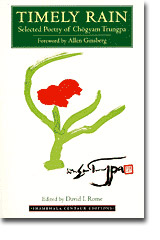Ruling Your World: Ancient Strategies for Modern Life

Author : Sakyong Mipham Rinpoche
It happens to most of us mo...
Excerpt from Ruling Your World
You're stuck in the airport security line, late for a flight. The line isn't moving. You're angry at the security personnel for taking so long, you're irritated at the other passengers for having so much stuff, you're mad at your boss for sending you on this trip in the first place. By the time you get to your gate you're deflated and exhausted. Then someone cuts in front of you in the line to board and you snap. "There's a line, you know!" Is that really you, standing in an airport, yelling at a stranger, emotions raging?It happens to most of us mo...
Turning the Mind Into an Ally

Author : Sakyong Mipham Rinpoche
Editorial Reviews
From Publishers Weekly
Is the mind our enemy? It can be, suggests Shambhala International's director Mipham in his first book. The key to peaceful and sane living, says Mipham, is training our minds. Without that training, people live "at the mercy of our moods." Meditation is the tool that can help spiritual seekers master, rather than be mastered by, their own minds. This book blends a philosophically savvy explanation of why meditation is necessary with an artful and accessible introduction to the basics of meditation. Mipham moves elegantly from the prosaic (how ...
Editorial Reviews
From Publishers Weekly
Is the mind our enemy? It can be, suggests Shambhala International's director Mipham in his first book. The key to peaceful and sane living, says Mipham, is training our minds. Without that training, people live "at the mercy of our moods." Meditation is the tool that can help spiritual seekers master, rather than be mastered by, their own minds. This book blends a philosophically savvy explanation of why meditation is necessary with an artful and accessible introduction to the basics of meditation. Mipham moves elegantly from the prosaic (how ...
"Shambhala, The Sacred Path of the Warrior"

Author : Chögyam Trungpa Edited by Carolyn Gimian Foreword by Osel Tendzin
"Meditation in Action"
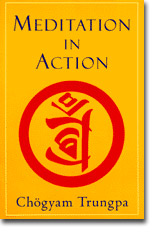
Author : Chögyam Trungpa
This classic teaching by a Tibetan master continues to inspire both beginners and long-time practitioners of Buddhist meditation. Chögyam Trungpa Rinpoche shows that meditation extends beyond the formal practice of sitting to build the foundation for compassion, Awareness, and creativity in all aspects of life. He explores the six activities associated with meditation in action--generosity, discipline, patience, energy, clarity, and wisdom--revealing that through simple, direct experience, one can attain real wisdom: the ability to see clearly into situations and deal with them skillfully, wi...
This classic teaching by a Tibetan master continues to inspire both beginners and long-time practitioners of Buddhist meditation. Chögyam Trungpa Rinpoche shows that meditation extends beyond the formal practice of sitting to build the foundation for compassion, Awareness, and creativity in all aspects of life. He explores the six activities associated with meditation in action--generosity, discipline, patience, energy, clarity, and wisdom--revealing that through simple, direct experience, one can attain real wisdom: the ability to see clearly into situations and deal with them skillfully, wi...
"Born in Tibet"
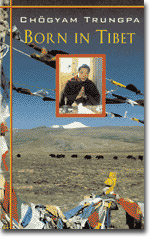
Author : Chögyam Trungpa
Foreword by Marco Pallis Chöyam Trungpa--meditation master, scholar, and artist--was identified at the age of only thirteen months as a major tulku, or reincarnation of an enlightened teacher. As the eleventh in the teaching lineage known as the Trungpa tulkus, he underwent a period of intensive training in meditation, philosophy, and fine arts, receiving full ordination as a monk in 1958 at the age of eighteen. The following year, the Chinese Communists invaded Tibet, and the young Trungpa spent many harrowing months trekking over the Himalayas, narrowly escaping capture. Trungpa's account o...
Foreword by Marco Pallis Chöyam Trungpa--meditation master, scholar, and artist--was identified at the age of only thirteen months as a major tulku, or reincarnation of an enlightened teacher. As the eleventh in the teaching lineage known as the Trungpa tulkus, he underwent a period of intensive training in meditation, philosophy, and fine arts, receiving full ordination as a monk in 1958 at the age of eighteen. The following year, the Chinese Communists invaded Tibet, and the young Trungpa spent many harrowing months trekking over the Himalayas, narrowly escaping capture. Trungpa's account o...
"Cutting Through Spiritual Materialism"

Author : Chögyam Trungpa
The now classic Cutting Through Spiritual Materialism is the record of two series of lectures given by Trungpa Rinpoche in 1970-71. "First discussed are the various ways in which people involve themselves in spiritual materialism, the many forms of self-deception into which aspirants may fell. After this tour of the sidetracks along the way, the broad outlines of the true spiritual path are discussed. The approach presented is a classical Buddhist one--not in a formal sense, but in the sense of presenting the heart of the Buddhist approach to spirituality. Although the Buddhist way is not thei...
The now classic Cutting Through Spiritual Materialism is the record of two series of lectures given by Trungpa Rinpoche in 1970-71. "First discussed are the various ways in which people involve themselves in spiritual materialism, the many forms of self-deception into which aspirants may fell. After this tour of the sidetracks along the way, the broad outlines of the true spiritual path are discussed. The approach presented is a classical Buddhist one--not in a formal sense, but in the sense of presenting the heart of the Buddhist approach to spirituality. Although the Buddhist way is not thei...
"Great Eastern Sun The Wisdom of Shambhala"

Author : Chögyam Trungpa Edited by Carolyn Gimian
The journey that began in Shambhala: The Sacred Path of the Warrior reaches a new level of intimacy and depth in this book, based on talks Chögyam Trungpa gave in the last ten years of his life. Trungpa possessed uncanny insight into our deepest fears, and how these are heightened by the pressures of today's society. He addresses many of them here: the speed and alienation of modern life; depression; materialism; aggression, anger, and anxiety; and a crippling lack of self-worth. Trungpa also held an unshakable belief in human goodness and our ability to create an enlightened human society. H...
The journey that began in Shambhala: The Sacred Path of the Warrior reaches a new level of intimacy and depth in this book, based on talks Chögyam Trungpa gave in the last ten years of his life. Trungpa possessed uncanny insight into our deepest fears, and how these are heightened by the pressures of today's society. He addresses many of them here: the speed and alienation of modern life; depression; materialism; aggression, anger, and anxiety; and a crippling lack of self-worth. Trungpa also held an unshakable belief in human goodness and our ability to create an enlightened human society. H...
"The Heart of the Buddha"

Author : Chögyam Trungpa
This compelling collection of essays, talks, and seminars by Chögyam Trungpa presents the basic teachings of Buddhism as they relate to everyday life. The book is divided into three parts. In "Personal Journey," the author discusses the qualities of openness, inquisitiveness, and good humor that characterize the enlightened Buddha-nature in everyone. In "Stages on the Path," he presents the three vehicles-- Hinayana,Mahayana, and Vajrayana --that carry the Buddhist practitioner toward Enlightenment. In "Working with Others," he describes the direct application of Buddhist teachings in such ar...
This compelling collection of essays, talks, and seminars by Chögyam Trungpa presents the basic teachings of Buddhism as they relate to everyday life. The book is divided into three parts. In "Personal Journey," the author discusses the qualities of openness, inquisitiveness, and good humor that characterize the enlightened Buddha-nature in everyone. In "Stages on the Path," he presents the three vehicles-- Hinayana,Mahayana, and Vajrayana --that carry the Buddhist practitioner toward Enlightenment. In "Working with Others," he describes the direct application of Buddhist teachings in such ar...
"The Myth of Freedom and the Way of Meditation"

Author : Chögyam Trungpa
Freedom is generally thought of as the ability to achieve goal and satisfy desires. But what are the sources of these goals and desires? If they arise from ignorance, habitual patterns, and negative emotions--psychologically destructive elements that actually enslave us--is the freedom to pursue them true freedom or just a myth? In this book, Chögyam Trungpa explores the meaning of freedom in the profound context of Tibetan Buddhism. He shows how our attitudes, preconceptions, and even our spiritual practices can become chains that bind us to repetitive patterns of frustration and despair. He...
Freedom is generally thought of as the ability to achieve goal and satisfy desires. But what are the sources of these goals and desires? If they arise from ignorance, habitual patterns, and negative emotions--psychologically destructive elements that actually enslave us--is the freedom to pursue them true freedom or just a myth? In this book, Chögyam Trungpa explores the meaning of freedom in the profound context of Tibetan Buddhism. He shows how our attitudes, preconceptions, and even our spiritual practices can become chains that bind us to repetitive patterns of frustration and despair. He...
"Training the Mind and Cultivating Loving-Kindness"

Author : Chögyam Trungpa
WARNING: Using this book could be hazardous to your ego! The slogans it contains are designed to awaken the heart and cultivate love and kindness toward others. They are revolutionary in that practicing them fosters abandonment of personal territory in relating to others and in understanding the world as it is. The fifty-nine provocative slogans presented here - each with a commentary by the Tibetan meditation master Chögyam Trungpa - have been used by Tibetan Buddhists for eight centuries, to help meditation students remember and focus on important principles and practices of mind training. ...
WARNING: Using this book could be hazardous to your ego! The slogans it contains are designed to awaken the heart and cultivate love and kindness toward others. They are revolutionary in that practicing them fosters abandonment of personal territory in relating to others and in understanding the world as it is. The fifty-nine provocative slogans presented here - each with a commentary by the Tibetan meditation master Chögyam Trungpa - have been used by Tibetan Buddhists for eight centuries, to help meditation students remember and focus on important principles and practices of mind training. ...
"The Art of Calligraphy"

Author : Chögyam Trungpa
During the twenty-year period of his remarkable proclamation of Buddhist and Shambhala teachings in the West, calligraphy was a primary means of expression for Chogyam Trungpa. This book showcases fifty-eight of his brushworks--poems, seed syllables, and phrases as well as abstract images. Facing them are short, pertinent quotations from his prose and poetry. An essay entitled "Heaven, Earth, and Man," based on one of Trungpa's "dharma art" workshops, is also included. Here he emphasizes what he called "art in everyday life": the cool, peaceful expression of unconditional beauty that offers us...
During the twenty-year period of his remarkable proclamation of Buddhist and Shambhala teachings in the West, calligraphy was a primary means of expression for Chogyam Trungpa. This book showcases fifty-eight of his brushworks--poems, seed syllables, and phrases as well as abstract images. Facing them are short, pertinent quotations from his prose and poetry. An essay entitled "Heaven, Earth, and Man," based on one of Trungpa's "dharma art" workshops, is also included. Here he emphasizes what he called "art in everyday life": the cool, peaceful expression of unconditional beauty that offers us...
"Crazy Wisdom"

Author : Chögyam Trungpa
Chögyam Trungpa describes "crazy wisdom" as an innocent state of mind thathas the quality of early morning--fresh, sparkling, and completely awake. This fascinating book examines the life of Padmasambhava--the revered Indian teacher who brought Buddhism to Tibet--to illustrate the principle of crazy wisdom. From this profound point of view, spiritual practice does not provide comfortable answers to pain or confusion. On the contrary, painful emotions can be appreciated as a challenging opportunity for new discovery. In particular, the author discusses meditation as a practical way to uncover ...
Chögyam Trungpa describes "crazy wisdom" as an innocent state of mind thathas the quality of early morning--fresh, sparkling, and completely awake. This fascinating book examines the life of Padmasambhava--the revered Indian teacher who brought Buddhism to Tibet--to illustrate the principle of crazy wisdom. From this profound point of view, spiritual practice does not provide comfortable answers to pain or confusion. On the contrary, painful emotions can be appreciated as a challenging opportunity for new discovery. In particular, the author discusses meditation as a practical way to uncover ...
"The Dawn of Tantra"

Author : Herbert V. Guenther, Chögyam Trungpa
Westerners wanting to know about tantra--particularly the Buddhist tantra of Tibet--often find only speculation and fancy. Tibet has been shrouded in mystery, and "tantra" has been called upon to name every kind of esoteric fantasy. In The Dawn of Tantra the reader meets a Tibetan meditation master and a Western scholar, each of whose grasp of Buddhist tantra is real and unquestionable. This collaboration is both true to the intent of the ancient Tibetan teachings and relevant to contemporary Western life.
Westerners wanting to know about tantra--particularly the Buddhist tantra of Tibet--often find only speculation and fancy. Tibet has been shrouded in mystery, and "tantra" has been called upon to name every kind of esoteric fantasy. In The Dawn of Tantra the reader meets a Tibetan meditation master and a Western scholar, each of whose grasp of Buddhist tantra is real and unquestionable. This collaboration is both true to the intent of the ancient Tibetan teachings and relevant to contemporary Western life.
"Dharma Art"
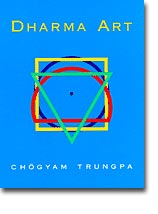
Author : Chögyam Trungpa. Edited by Judith Lief
"Dharma art" refers to creative works that spring from the awakened meditative state, characterized by directness, unselfconsciousness, and nonaggression. Trungpa Rinpoche shows that dharma art provides a vehicle to appreciate the nature of things as they are and express it without any struggle or desire to achieve
"Dharma art" refers to creative works that spring from the awakened meditative state, characterized by directness, unselfconsciousness, and nonaggression. Trungpa Rinpoche shows that dharma art provides a vehicle to appreciate the nature of things as they are and express it without any struggle or desire to achieve
"Glimpses of Abidharma" From a Seminar on Buddhist Psychology
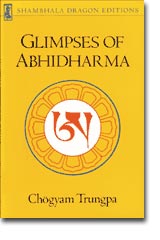
Author : Chögyam Trungpa
The Abhidharma is a collection of Buddhist scriptures that investigate the workings of the mind and the states of human consciousness. In this book, Chögyam Trungpa shows how an examination of the formation of the ego provides us with an opportunity to develop real intelligence. Trungpa also presents the practice of meditation as the means that enables us to see our psychological situation clearly and directly.
The Abhidharma is a collection of Buddhist scriptures that investigate the workings of the mind and the states of human consciousness. In this book, Chögyam Trungpa shows how an examination of the formation of the ego provides us with an opportunity to develop real intelligence. Trungpa also presents the practice of meditation as the means that enables us to see our psychological situation clearly and directly.
"Illusion's Game. The Life and Teaching of Naropa "

Author : Chögyam Trungpa
In what he calls a "200 percent potent" teaching, Chögyam Trungpa reveals how the spiritual path is a raw and rugged "unlearning" process that draws us away from the comfort of conventional expectations and conceptual attitudes toward a naked encounter with reality. The tantric paradigm for this process is the story of the Indian master Naropa (1016-1100), who is among the enlightened teachers of the Kagyu lineage of the Tibetan Buddhism. Naropa was the leading scholar at Nalanda, the Buddhist monastic university, when he embarked upon the lonely and arduous path to Enlightenment. After a ser...
In what he calls a "200 percent potent" teaching, Chögyam Trungpa reveals how the spiritual path is a raw and rugged "unlearning" process that draws us away from the comfort of conventional expectations and conceptual attitudes toward a naked encounter with reality. The tantric paradigm for this process is the story of the Indian master Naropa (1016-1100), who is among the enlightened teachers of the Kagyu lineage of the Tibetan Buddhism. Naropa was the leading scholar at Nalanda, the Buddhist monastic university, when he embarked upon the lonely and arduous path to Enlightenment. After a ser...
"The Life of Marpa the Translator"

Author : Translated by Nalanda Translation Committee, Chögyam Trungpa
Marpa the Translator, the eleventh-century farmer, scholar, and teacher, is one of the most renowned saints in Tibetan Buddhist history. In the West, Marpa is best known through his teacher, the Indian yogin Naropa, and through his closest disciple, Milarepa. This lucid and moving translation of a text composed by the author of The Life of Milarepa and The Hundred Thousand Songs of Milarepa documents the fascinating life of Marpa, who, unlike many other Tibetan masters, was a layman, a skillful businessman who raised a family while training his disciples. As a youth, Marpa was inspired to trav...
Marpa the Translator, the eleventh-century farmer, scholar, and teacher, is one of the most renowned saints in Tibetan Buddhist history. In the West, Marpa is best known through his teacher, the Indian yogin Naropa, and through his closest disciple, Milarepa. This lucid and moving translation of a text composed by the author of The Life of Milarepa and The Hundred Thousand Songs of Milarepa documents the fascinating life of Marpa, who, unlike many other Tibetan masters, was a layman, a skillful businessman who raised a family while training his disciples. As a youth, Marpa was inspired to trav...
"The Lion's Roar"

Author : Chögyam Trungpa
This book is based on two historic seminars of the 1970s, in which Chögyam Trungpa introduced the tantric teachings of Tibetan Buddhism to his Western students for the first time. Each seminar bore the title "The Nine Yanas." Yana, a Sanskrit word meaning "vehicle," refers to a body of doctrine and practical instruction that enables students to advance spiritually on the path of Buddha-dharma. Nine vehicles, arranged in successive levels, make up the whole path of Buddhist practice. Teaching all nine means giving a total picture of the spiritual journey. The author's nontheoretical, experient...
This book is based on two historic seminars of the 1970s, in which Chögyam Trungpa introduced the tantric teachings of Tibetan Buddhism to his Western students for the first time. Each seminar bore the title "The Nine Yanas." Yana, a Sanskrit word meaning "vehicle," refers to a body of doctrine and practical instruction that enables students to advance spiritually on the path of Buddha-dharma. Nine vehicles, arranged in successive levels, make up the whole path of Buddhist practice. Teaching all nine means giving a total picture of the spiritual journey. The author's nontheoretical, experient...
"Mudra Early Poems and Songs "
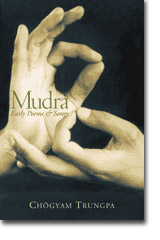
Author : Chögyam Trungpa
A mudra is a symbolic gesture or action that gives physical expression to an inner state. This book of poetry and songs of devotion, written by Chögyam Trungpa between 1959 and 1971, is spontaneous and celebratory. This volume also includes the ten traditional Zen oxherding pictures accompanied by a unique commentary that offers an unmistakably Tibetan flavor. Fans of this renowned teacher will enjoy the heartfelt devotional quality of this early work.
A mudra is a symbolic gesture or action that gives physical expression to an inner state. This book of poetry and songs of devotion, written by Chögyam Trungpa between 1959 and 1971, is spontaneous and celebratory. This volume also includes the ten traditional Zen oxherding pictures accompanied by a unique commentary that offers an unmistakably Tibetan flavor. Fans of this renowned teacher will enjoy the heartfelt devotional quality of this early work.
"The Tibetan Book of the Dead The Great Liberation through Hearing in the Bardo "
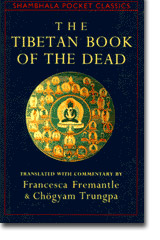
Author : Translated by Francesca Fremantle, Chögyam Trungpa
In this classic of the world's religious literature - traditionally read aloud to the dying - death and rebirth are seen as a process that offers the possibility of attaining ultimate liberation. This unabridged translation emphasizes the practical advice that the book offers to the living. The insightful commentary by the renowned meditation master Chögyam Trungpa explains what the scripture teaches about human psychology.
In this classic of the world's religious literature - traditionally read aloud to the dying - death and rebirth are seen as a process that offers the possibility of attaining ultimate liberation. This unabridged translation emphasizes the practical advice that the book offers to the living. The insightful commentary by the renowned meditation master Chögyam Trungpa explains what the scripture teaches about human psychology.
Awakening Loving-Kindness

Author : Pema Chodron
This book is about saying yes to life, about making friends with ourselves and our world, about accepting the delightful and painful situation of "no-exit." It exhorts us to wake up wholeheartedly to everything and to use the abundant richly textured fabric of everyday life as our primary spiritual teacher and guide.
This book is about saying yes to life, about making friends with ourselves and our world, about accepting the delightful and painful situation of "no-exit." It exhorts us to wake up wholeheartedly to everything and to use the abundant richly textured fabric of everyday life as our primary spiritual teacher and guide.
The Places That Scare You. A Guide to Fearlessness in Difficult Times.
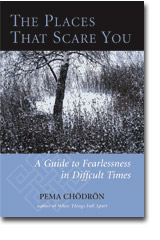
Author : Pema Chodron
In The Places That Scare You, Pema Chödrön continues the teachings of When Things Fall Apart, showing how at the core of the most painful experiences lie the seeds of spiritual awakening. Here she presents key teachings on recognizing and cultivating the "soft spot" that is the gateway to compassion and open-heartedness. In this book she discusses: The four great catalysts of awakening, and how to integrate them into our lives Why the "soft spot" is necessary for spiritual awakening The basic goodness that is inherently ours How the three noble principles can enrich everything we do The mait...
In The Places That Scare You, Pema Chödrön continues the teachings of When Things Fall Apart, showing how at the core of the most painful experiences lie the seeds of spiritual awakening. Here she presents key teachings on recognizing and cultivating the "soft spot" that is the gateway to compassion and open-heartedness. In this book she discusses: The four great catalysts of awakening, and how to integrate them into our lives Why the "soft spot" is necessary for spiritual awakening The basic goodness that is inherently ours How the three noble principles can enrich everything we do The mait...
Start Where You Are

Author : Pema Chodron
With insight and humor, Pema Chödrön presents down-to-earth guidance on how we can "start where we are"--embracing rather than denying the painful aspects of our lives. Pema Chödrön frames her teachings on compassion around fifty-nine traditional Tibetan Buddhist maxims, or slogans, such as: "Always apply only a joyful state of mind," "Don't seek others' pain as the limbs of your own happiness," and "Always meditate on whatever provokes resentment."
With insight and humor, Pema Chödrön presents down-to-earth guidance on how we can "start where we are"--embracing rather than denying the painful aspects of our lives. Pema Chödrön frames her teachings on compassion around fifty-nine traditional Tibetan Buddhist maxims, or slogans, such as: "Always apply only a joyful state of mind," "Don't seek others' pain as the limbs of your own happiness," and "Always meditate on whatever provokes resentment."
When Things Fall Apart. Heart Advice for Difficult Times.
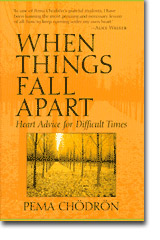
Author : Pema Chodron
The beautiful practicality of her teaching has made Pema Chödrön one of the most beloved of contemporary American spiritual authors among Buddhists and non-Buddhists alike. A collection of talks she gave between 1987 and 1994, the book is a treasury of wisdom for going on living when we are overcome by pain and difficulties. Chödrön discusses: * using painful emotions to cultivate wisdom, compassion, and courage * communicating so as to encourage others to open up rather than shut down * practices for reversing habitual patterns * methods for working with chaotic situations * ways for crea...
The beautiful practicality of her teaching has made Pema Chödrön one of the most beloved of contemporary American spiritual authors among Buddhists and non-Buddhists alike. A collection of talks she gave between 1987 and 1994, the book is a treasury of wisdom for going on living when we are overcome by pain and difficulties. Chödrön discusses: * using painful emotions to cultivate wisdom, compassion, and courage * communicating so as to encourage others to open up rather than shut down * practices for reversing habitual patterns * methods for working with chaotic situations * ways for crea...
The Wisdom of No Escape
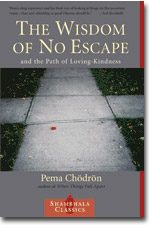
Author : Pema Chodron
This book is about saying yes to life in all its manifestations--embracing the potent mixture of joy, suffering, brilliance, and confusion that characterizes the human experience. Pema Chödrön shows us the profound value of our situation of "no escape" from the ups and downs of life.
This book is about saying yes to life in all its manifestations--embracing the potent mixture of joy, suffering, brilliance, and confusion that characterizes the human experience. Pema Chödrön shows us the profound value of our situation of "no escape" from the ups and downs of life.
Sacred World : The Shambhala Way to Gentleness, Bravery, and Power

Author : Jeremy Hayward, Karen Hayward
The Haywards take the reader on a journey through ordinary experience into the sacred world, uncovering obstacles to living in sacredness and exploring ways to work with these obstacles. Their meditations, personal insights, anecdotes, and Mindfulness exercises guide the reader toward self-knowledge and empathy... A helpful addition to collections on Western and Eastern approaches to living." -Library Journal "Being a warrior has nothing to do with waging war. Being a warrior means you have the courage to know who you are. Warriors never give up on anyone, including themselves."-from Sacred Wo...
The Haywards take the reader on a journey through ordinary experience into the sacred world, uncovering obstacles to living in sacredness and exploring ways to work with these obstacles. Their meditations, personal insights, anecdotes, and Mindfulness exercises guide the reader toward self-knowledge and empathy... A helpful addition to collections on Western and Eastern approaches to living." -Library Journal "Being a warrior has nothing to do with waging war. Being a warrior means you have the courage to know who you are. Warriors never give up on anyone, including themselves."-from Sacred Wo...
Dakini's Warm Breath. The Feminine Principle in Tibetan Buddhism
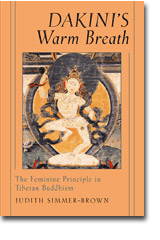
Author : Judith Zimmer-Brown
The primary emblem of the feminine in Tibetan Buddhism is the dakini, or "sky-dancer," a semi-wrathful spirit-woman who manifests in visions, dreams, and meditation experiences. Western scholars and interpreters of the dakini, influenced by Jungian psychology and feminist goddess theology, have shaped a contemporary critique of Tibetan Buddhism in which the dakini is seen as a psychological "shadow," a feminine savior, or an objectified product of patriarchal fantasy. According to Judith Simmer-Brown--who writes from the point of view of an experienced practitioner of Tibetan Buddhism--such in...
The primary emblem of the feminine in Tibetan Buddhism is the dakini, or "sky-dancer," a semi-wrathful spirit-woman who manifests in visions, dreams, and meditation experiences. Western scholars and interpreters of the dakini, influenced by Jungian psychology and feminist goddess theology, have shaped a contemporary critique of Tibetan Buddhism in which the dakini is seen as a psychological "shadow," a feminine savior, or an objectified product of patriarchal fantasy. According to Judith Simmer-Brown--who writes from the point of view of an experienced practitioner of Tibetan Buddhism--such in...
Making Friends with Death A Buddhist Guide to Encountering Mortality
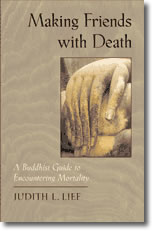
Author : Judith Lief
In Making Friends with Death, Buddhist teacher Judith Lief, who's drawn her inspiration from The Tibetan Book of the Dead, shows us that through the powerful combination of contemplation of death and Mindfulness practice, we can change how we relate to death, enhance our appreciation of everyday life, and use our developing acceptance of our own vulnerability as a basis for opening to others. She also offers a series of guideline to help us reconnect with dying persons, whether they are friends or family, clients or patients. Lief highlights the value of relating to the immediacy of death as a...
In Making Friends with Death, Buddhist teacher Judith Lief, who's drawn her inspiration from The Tibetan Book of the Dead, shows us that through the powerful combination of contemplation of death and Mindfulness practice, we can change how we relate to death, enhance our appreciation of everyday life, and use our developing acceptance of our own vulnerability as a basis for opening to others. She also offers a series of guideline to help us reconnect with dying persons, whether they are friends or family, clients or patients. Lief highlights the value of relating to the immediacy of death as a...

